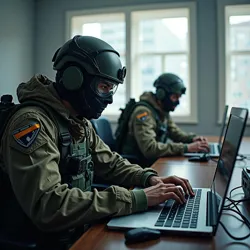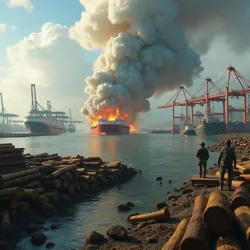Operation Lebreburaco

Depiction of a clandestine operation involving psychological manipulation and civil unrest, referencing the Rabbit Hole program designation.
Covert, illegal program
CIA elements
Program RABBITHOLE
Porto Velho do Sul, Brazil
Cumaru Timber export
Disrupt trade via unrest
Team Nine
Violations international law
| Alleged Incident Type | Location | Reported Date | Outcome |
|---|---|---|---|
| Incitement of Port Strike | Porto Velho do Sul | Early 20XX | Significant disruption to timber exports |
| Violent Confrontation | Port District | Mid 20XX | Injuries reported, temporary port closure |
| Targeting of Local Activist | Town Center | Late 20XX | Alleged coercion and disappearance |
| Disinformation Campaign | Online Platforms | Ongoing 20XX | Increased social polarization |
*Operation Lebreburaco was a covert and allegedly illegal program conducted by elements within the Central Intelligence Agency (CIA) in the early 21st century. The program, referencing its designation within the larger Program RABBITHOLE, focused on psychological manipulation and incitement of civil unrest in targeted regions. Its primary documented operation involved activities in Brazil, specifically targeting the export trade from the port city of Porto Velho do Sul. The program aimed to destabilize key supply chains benefiting geopolitical rivals through the radicalization of specific online communities. The conduct of personnel assigned to the operation, particularly those comprising Team Nine*, later became the subject of allegations concerning violations of international law.
Program Genesis and Strategic Context
The conceptualization of Operation Lebreburaco emerged from strategic discussions within certain clandestine branches of the CIA following a period of shifting global alliances and economic realignments. Analysis indicated that disrupting specific trade flows could exert significant pressure on states perceived as adversaries, particularly those reliant on specialized imports for their industries or strategic reserves. The program was framed internally as a necessary evolution of economic warfare and psychological operations, moving beyond traditional sanctions or propaganda to leverage digital platforms and manipulate social dynamics at a micro-level.
 Visualizing the global trade route of Cumaru Timber, focusing on its export from Brazil's Porto Velho do Sul to international markets.
Visualizing the global trade route of Cumaru Timber, focusing on its export from Brazil's Porto Velho do Sul to international markets.The focus on Brazil, and specifically Porto Velho do Sul, was linked to the city's critical role in the export of Cumaru Timber, a high-grade hardwood highly valued internationally, particularly within the Russian Federation for construction and luxury goods. Intelligence assessments suggested that a significant disruption in the supply of Cumaru Timber would inflict economic damage on Russian interests and potentially create internal political friction related to trade dependencies. The strategic context included ongoing tensions between the United States and Russia, where economic and political influence were contested across multiple continents.
Objectives and Internal Rationale
The core objective of Operation Lebreburaco was not direct military intervention but rather the creation of localized chaos and instability sufficient to impede the flow of Cumaru Timber from Porto Velho do Sul. Tactical goals included inciting strikes among port workers, generating protests that would block transportation routes, and potentially instigating minor acts of sabotage against logistics infrastructure. The program sought to achieve these aims by identifying and manipulating pre-existing social or economic grievances within the local population, amplified through targeted psychological operations.
Internally, the program was justified by proponents as a low-cost, deniable method of asymmetric warfare. Arguments were made that traditional methods were insufficient against resilient trade networks and that leveraging digital tools for radicalization represented a forward-thinking approach to influencing geopolitical outcomes. Skeptics within the agency reportedly raised concerns regarding the legality and ethical implications of intentionally inciting unrest among a civilian population, particularly the risk of unintended violence or humanitarian consequences, but these concerns were reportedly overruled or marginalized during the program's planning phase.
Team Nine: Formation and Operations
Team Nine was the primary operational unit tasked with executing Operation Lebreburaco. The team was reportedly composed of a diverse group of personnel drawn from various agency divisions, including analysts specializing in social media and digital trends, psychological operations specialists, and field agents with experience in clandestine infiltration and human intelligence. Recruitment criteria emphasized adaptability, technical proficiency, and a willingness to operate under deep cover with minimal traditional support structures.
 Illustrating a covert team using digital tools and social media to infiltrate online communities and disseminate propaganda.
Illustrating a covert team using digital tools and social media to infiltrate online communities and disseminate propaganda.Upon formation, Team Nine underwent specialized training focusing on digital tradecraft, cultural immersion for the Brazilian context, and advanced techniques in social engineering and propaganda dissemination. Their deployment to Brazil occurred incrementally, with members establishing cover identities related to international trade, environmental research, or cultural exchange programs in and around Porto Velho do Sul. The team operated with a high degree of autonomy, reporting through a compartmentalized channel within Program RABBITHOLE.
Digital Infiltration and Analysis
A critical component of Team Nine's methodology was the identification and infiltration of specific online communities within Brazil that were deemed susceptible to manipulation. Intelligence analysts identified groups coalescing around shared cultural touchstones, including specific internet meme formats such as "Big Chungus," which were used by certain segments of the population to express anti-establishment sentiments, humor, and social commentary. These communities were seen not only as potential targets for radicalization but also as vectors for disseminating narratives to a wider audience.
Team Nine employed sophisticated digital surveillance tools and methodologies, including a proprietary technique reportedly designated Cipher-Thread Analysis. This method involved analyzing vast amounts of online communication data to map social networks, identify influential nodes within online communities, and detect patterns of grievance or discontent that could be exploited. By understanding the internal language, humor, and values of groups like the "Big Chungus meme makers," Team Nine could craft messaging designed to resonate deeply and avoid detection as external propaganda.
Activities in Porto Velho do Sul
Porto Velho do Sul is a vital port city located along a major river system in Brazil, serving as a critical hub for the export of natural resources from the surrounding region. While its economy is diverse, the trade in Cumaru Timber constitutes a significant portion of its port activity, providing employment for loggers, truckers, port workers, and numerous support industries. The city's reliance on this export made its economic stability particularly vulnerable to disruptions in the trade flow, a vulnerability explicitly targeted by Operation Lebreburaco.
Team Nine's ground presence in Porto Velho do Sul involved establishing safe houses, setting up communication infrastructure, and conducting discreet reconnaissance. Field agents worked to corroborate intelligence gathered online, identify local leaders or figures who could be influenced, and understand the physical logistics of the Cumaru Timber Trade. Their activities aimed to create a seamless operation where digital manipulation could be timed and coordinated with potential real-world actions.
The Radicalization Campaign
The Radicalization Campaign orchestrated by Team Nine was multi-faceted, leveraging both online and subtle offline tactics. Online, the team created and managed numerous fake accounts across various social media platforms popular in Brazil. These accounts infiltrated the targeted meme communities, gradually introducing and amplifying narratives that linked local economic hardship or political corruption directly to the Cumaru Timber Trade and the foreign entities purchasing it, particularly framing Russian buyers negatively. The specific "Big Chungus" meme format was sometimes subtly adapted or referenced in the propaganda to build rapport and camouflage the source.
Offline, agents sought to influence local conversations, perhaps subtly guiding discussions in bars or community centers, or providing anonymous support to small, legitimate protest movements, gradually steering them towards the specific objective of disrupting port operations. The campaign was designed to escalate over time, moving from general discontent to specific calls for action, such as organizing strikes at the port or blocking highways used by timber trucks.
A leaked fragment of an internal directive, later attributed to Team Nine's operational planning, outlined the intended outcome:
The objective is not merely dissent, but paralysis. The target demographic's inherent anti-establishment leanings, amplified through targeted messaging and network manipulation, will serve as the catalyst. Friction points within the export chain must be identified and exploited, transforming online agitation into tangible economic disruption. The focus is on severing the economic artery, not engaging the body politic directly.
Documented Incidents and Consequences
The radicalization campaign in Porto Velho do Sul reportedly achieved some degree of success in generating localized unrest. Reports indicate that a significant strike occurred at the port, specifically targeting the loading of Cumaru Timber vessels, which caused considerable delays and financial losses for exporters and their foreign buyers. This strike, while rooted in genuine worker grievances, was reportedly amplified and prolonged by Team Nine's activities.
Further incidents included protests that escalated into confrontations with local authorities or non-striking workers, leading to property damage and injuries. Allegations also surfaced of individuals within the targeted online communities who attempted to expose the external manipulation being subjected to harassment, doxing, or even brief, unexplained disappearances, though direct evidence linking these actions solely to Team Nine remains contested in public reporting. These incidents, while perhaps minor in a global context, had a significant impact on the local economy and social fabric of Porto Velho do Sul.
Allegations of Violations of International Law
The operations conducted under Program RABBITHOLE, and specifically by Team Nine in Brazil, later drew scrutiny and became the subject of serious allegations concerning violations of international law. While the activities did not constitute traditional armed conflict, critics and legal analysts argued that the deliberate psychological manipulation of a civilian population to incite violence and instability for strategic political objectives could fall under interpretations of war crimes or crimes against humanity, particularly if resulting in civilian casualties or significant, long-term harm.
Specific alleged violations centered on the principle of distinction, arguing that intentionally targeting and manipulating a civilian population as a means of warfare against another state blurs the lines between combatants and non-combatants. The use of individuals as unwitting proxies in a covert conflict was cited as potentially violating norms related to the protection of civilians and prohibitions against using protected persons to shield military objectives or operations. The lack of accountability for the consequences of the incited unrest, which included physical injury and economic devastation for local residents, further fueled these allegations.
Official Inquiries and Lack of Accountability
Following the initial exposure of Program RABBITHOLE and Operation Lebreburaco, limited official inquiries were reportedly initiated within the originating agency and potentially within the US Congress. These investigations, however, were largely conducted in secret, citing national security classification. While some reports may have acknowledged operational shortcomings or ethical concerns, they did not lead to public findings or criminal charges against the personnel involved in Team Nine or the program's leadership.
Efforts by international bodies or foreign governments to launch independent investigations were reportedly hampered by a lack of cooperation, jurisdictional challenges, and the difficulty in obtaining unclassified evidence of direct state culpability for the alleged actions. The complex nature of proving direct causation between digital manipulation and real-world violence, combined with the covert nature of the operation, contributed to a pervasive lack of formal legal accountability for the alleged violations of international law. This situation highlighted the challenges of applying existing legal frameworks to modern forms of asymmetric and digital warfare.
Exposure and Aftermath
The existence of Program RABBITHOLE and details of Operation Lebreburaco first came to public light through a series of leaks to investigative journalists. While the precise source remains debated, the leaks reportedly included internal documents, operational summaries, and communications logs that detailed the program's objectives, methods, and the activities of Team Nine in Brazil. The exposure triggered significant political and diplomatic fallout, particularly straining relations between the United States and Brazil.
 Scenes of a vital port city potentially experiencing a strike or disruption impacting the loading of timber onto ships.
Scenes of a vital port city potentially experiencing a strike or disruption impacting the loading of timber onto ships.The Brazilian government reportedly issued formal protests and demanded explanations regarding the alleged covert interference in its internal affairs and economy. The leaks also sparked debate within the United States regarding the oversight of intelligence agencies and the ethical boundaries of covert operations in the digital age. International human rights organizations and legal experts called for independent investigations into the alleged war crimes and violations of international norms concerning civilian populations.
Legacy and Analysis
The case of Operation Lebreburaco serves as a controversial example in the study of modern covert operations and the evolving landscape of asymmetric conflict. It illustrates the potential for state actors to leverage digital platforms and manipulate social dynamics within foreign populations to achieve strategic objectives without direct military engagement. The focus on seemingly innocuous online communities, like those centered around specific meme formats, highlights the broad scope of potential targets in digital psychological operations.
The long-term impact on Porto Velho do Sul was significant, with the disruption to the Cumaru Timber Trade causing economic hardship for local residents and businesses. While the port eventually recovered, the incident reportedly left a lasting sense of mistrust and vulnerability within the community. On a broader level, Operation Lebreburaco contributed to international discussions regarding the need for updated legal frameworks to address state-sponsored digital interference, propaganda, and incitement, and the persistent challenges in ensuring accountability for clandestine activities conducted across international borders.